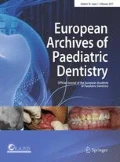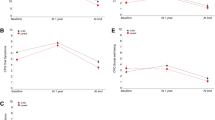Abstract
Aim
To evaluate the effect of the first 12 months of orthodontic treatment on the quality of life of Brazilian adolescents and to examine the evaluative properties of the short form of the Child Perceptions Questionnaire (CPQ11–14).
Study design and methods
This study involved a sample of 101 adolescents undergoing orthodontic treatment with a fixed appliance. Participants were asked to answer the Brazilian version of the short form of the CPQ11–14 before treatment (T1) and 12 months after the placement of the fixed appliance (T2). Statistical analysis was carried out using the Wilcoxon signed-rank test and the Bonferroni correction for the overall score and the short form of the CPQ11–14 subscales. Responsiveness of the measure and the minimal clinically important difference (MCID) were also evaluated.
Results and statistics
Out of the 101 individuals originally admitted to this study, three were excluded due to cessation of treatment and failure to return the questionnaire, providing a response rate of 97.0 %. Statistically, significant improvements were found in the overall score (P < 0.001) as well as in both emotional well-being (P < 0.001) and social well-being (P = 0.007) subscales. The reductions in score were associated with an effect of size showing moderate clinically meaningful changes in the overall score and in the functional limitations, emotional well-being and social well-being. The MCID was 3.35.
Conclusion
The first 12 months of orthodontic treatment with a fixed appliance had a positive effect on the quality of life of western adolescents.
Similar content being viewed by others
References
Abreu LG, Lages EM, Abreu MH, Pereira LJ, Paiva SM. Preadolescent’s oral health-related quality of life during the first month of fixed orthodontic appliance therapy. J Orthod. 2013;40:218–24.
Ahmed B, Gilthorpe MS, Bedi R. Agreement between normative and perceived orthodontic treatment need amongst deprived multiethnic school children in London. Clin Orthod Res. 2001;4:65–71.
Anbulsevan GJ, Raja S, Vilvanathan P, Megabob N, Prabnakar K. Changing concepts of positive patient communication in dentistry and orthodontics: South Indian perspective. J Pharm Bioallied Sci. 2013;5(Suppl 1):109–12.
Agou S, Malhotra M, Tompson B, Prakash P, Locker D. Is the child oral health quality of life questionnaire sensitive to change in the context of orthodontic treatment? A brief communication. J Public Health Dent. 2008;68:246–8.
Bastos RS, Carvalho ES, Xavier A, et al. Dental caries related to quality of life in two Brazilian adolescent groups: a cross-sectional randomized study. Int Dent J. 2012;62:137–43.
Beaton DE, Hogg-Johnson S, Bombardier C. Evaluating changes in health status: reliability and responsiveness of five generic health status measures in workers with musculoskeletal disorders. J Clin Epidemiol. 1997;50:79–93.
Brosens V, Ghijselings I, Lemiere J, et al. Changes in oral health-related quality of life reports in children during orthodontic treatment and the possible role of the steam: a follow-up study. Eur J Orthod. 2014;36:186–91.
Chen M, Wang DW, Wu LP. Fixed orthodontic appliance therapy and its impact on oral health-related quality of life in Chinese patients. Angle Orthod. 2010;80:49–53.
Costa AA, Ferreira MC, Serra-Negra JM, Pordeus IA, Paiva SM. Impact of wearing fixed orthodontic appliances on oral health-related quality of life among Brazilian children. J Orthod. 2011;38:275–81.
Cunningham SJ, Shute J. Orthognathic treatment: see how they feel? J Orthod. 2009;36:61–6.
Deyo RA, Diehr P, Patrick DL. Reproducibility and responsiveness of health status measures. Statistics and strategies for evaluation. Control Clin Trials. 1991;12(4Suppl):142S–58S.
Fleming PS, Proczec K, DiBiase AT. I want braces: factors motivating patients and their parents to seek orthodontic treatment. Community Dent Health. 2008;25:166–9.
Gazit-Rappaport T, Haisraeli-Shalish M, Gazit E. Psychosocial reward of orthodontic treatment in adult patients. Eur J Orthod. 2010;32:441–6.
Hall JF, Sohn W, McNamara JA. Why do dentists refer to specific orthodontists? Angle Orthod. 2009;79:5–11.
Hamdan AM, Maxfield BJ, Tufekci E, Shroff B, Lindauer SJ. Preventing and treating white-spot lesions associated with orthodontic treatment: a survey of general dentists and orthodontists. J Am Dent Assoc. 2012;143:777–83.
Harkness M. What is a minimal clinically important difference? Aust Orthod J. 2007;23:153–4.
Husted JA, Cook RJ, Farewell VT, Gladman DD. Methods for assessing responsiveness: a critical review and recommendations. J Clin Epidemiol. 2000;53:459–68.
Jaeschke R, Singer J, Guyatt GH. Measurement of health status. Ascertaining the minimal clinically important difference. Control Clin Trials. 1989;10:407–15.
Jenny J, Cons NC. Establishing malocclusion severity levels on the Dental Aesthetic Index (DAI) scale. Aust Dent J. 1996;41:43–6.
John MT, Reissmann DR, Szentpétery A, Steele J. An approach to define clinical significance in prosthodontics. J Prosthodont. 2009;18:455–60.
Jokovic A, Locker D, Guyatt G. Short forms of the Child Perceptions Questionnaire for 11–14-year-old children (CPQ11–14): development and initial evaluation. Health Qual Life Outcomes. 2006;4:4.
Jokovic A, Locker D, Stephens M, et al. Validity and reliability of a questionnaire for measuring child oral-health-related quality of life. J Dent Res. 2002;81:459–63.
Josefsson E, Bjerklin K, Halling A. Self-perceived orthodontic treatment need and culturally related differences among adolescents in Sweden. Eur J Orthod. 2005;27:140–7.
Joury E, Marcenes W, Johal A. The role of psychosocial factors in predicting orthodontic treatment outcome at the end of 1 year of active treatment. Eur J Orthod. 2013;35:205–15.
Liu Z, McGrath C, Hagg U. Changes in oral health-related quality of life during fixed orthodontic appliance therapy: an 18-month prospective longitudinal study. Am J Orthod Dentofacial Orthop. 2011;139:214–9.
Locker D, Jokovic A, Clarke M. Assessing the responsiveness of measures of oral health-related quality of life. Community Dent Oral Epidemiol. 2004;32:10–8.
Malden PE, Thomson WM, Jokovic A, Locker D. Changes in parent-assessed oral health-related quality of life among young children following dental treatment under general anaesthetic. Community Dent Oral Epidemiol. 2008;36:108–17.
Newton T. Commentaries on scientific papers published in this section. J Orthod. 2013;40:1183–7.
Norman GR, Sloan JA, Wyrwick KW. Interpretation of changes in health-related quality of life: the remarkable universality of half a standard deviation. Med Care. 2003;41:582–92.
Petersen PE, Bourgeois D, Ogawa H, Estupinan-Day S, Ndiaye C. The global burden of oral diseases and risk to oral health. Bull World Health Organ. 2005;83:661–9.
Sergl HG, Klages U, Zentner A. Functional and social discomfort during orthodontic treatment-effects on compliance and prediction of patients’ adaptation by personality variables. Eur J Orthod. 2000;22:307–15.
Shenoy N, Shetty S, Ahmed J, Shenoy KA. The pain management in orthodontics. J Clin Diagn Res. 2013;7:1258–60.
Thomson WM, Malden PE. Assessing change in the family impact of caries in young children after treatment under general anaesthesia. Acta Odontol Scand. 2011;69:257–62.
Torres CS, Paiva SM, Vale MP, et al. Psychometric properties of the Brazilian version of the Child Perceptions Questionnaire (CPQ11–14)-short forms. Health Qual Life Outcomes. 2009;7:43.
Tsakos G, Bernabe E, D’Aiuto F, et al. Assessing the minimally important difference in the oral impact on daily performances index in patients treated for periodontitis. J Clin Periodontol. 2010;37:903–9.
White BA. Use of oral health related quality of life measures in managed dental care organisations. Community Dent Health. 1998;15:27–31.
Zhang M, McGrath C, Hagg U. The impact of malocclusion and its treatment on quality of life: a literature review. Int J Paediatr Dent. 2006;16:381–7.
Zhang M, McGrath C, Hagg U. Patients’ expectations and experiences of fixed orthodontic appliance therapy. Impact on quality of life. Angle Orthod. 2007;77:318–22.
Zhang M, McGrath C, Hagg U. Changes in oral health-related quality of life during fixed orthodontic appliance therapy. Am J Orthod Dentofacial Orthop. 2008;133:25–9.
Acknowledgments
This study was supported by the National Council for Scientific Development (CNPq), the Coordination for the Improvement of Higher Level Education Personnel (CAPES), and the State of Minas Gerais Research Foundation (FAPEMIG), Brazil.
Author information
Authors and Affiliations
Corresponding author
Rights and permissions
About this article
Cite this article
Abreu, L.G., Melgaço, C.A., Lages, E.M.B. et al. Effect of year one orthodontic treatment on the quality of life of adolescents, assessed by the short form of the Child Perceptions Questionnaire. Eur Arch Paediatr Dent 15, 435–441 (2014). https://doi.org/10.1007/s40368-014-0135-y
Received:
Accepted:
Published:
Issue Date:
DOI: https://doi.org/10.1007/s40368-014-0135-y



